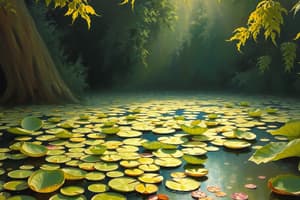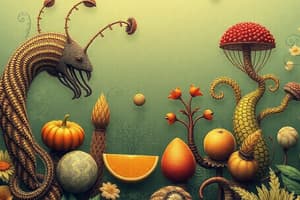Podcast
Questions and Answers
What are autotrophs?
What are autotrophs?
An organism that produces complex organic compounds from simple substances using energy from light or inorganic chemical reactions.
What are heterotrophs?
What are heterotrophs?
An organism that cannot fix carbon and uses organic carbon for growth.
What are producers?
What are producers?
Any green plant or various microorganisms that can convert light energy or chemical energy into organic matter.
What are photoautotrophs?
What are photoautotrophs?
Describe the structure of chloroplasts and their location in a leaf.
Describe the structure of chloroplasts and their location in a leaf.
How do plants produce oxygen during photosynthesis?
How do plants produce oxygen during photosynthesis?
What are the reactants and products of the light reactions in photosynthesis?
What are the reactants and products of the light reactions in photosynthesis?
How do photosystems capture solar energy?
How do photosystems capture solar energy?
Explain how the electron transport chain and chemiosmosis generate ATP and NADPH.
Explain how the electron transport chain and chemiosmosis generate ATP and NADPH.
Describe the reactants and products of the Calvin cycle.
Describe the reactants and products of the Calvin cycle.
How do C3, C4, and CAM plants obtain and use carbon dioxide?
How do C3, C4, and CAM plants obtain and use carbon dioxide?
Describe the greenhouse effect.
Describe the greenhouse effect.
Flashcards are hidden until you start studying
Study Notes
Autotrophs and Heterotrophs
- Autotrophs produce complex organic compounds using simple substances, energy is derived from light (photosynthesis) or inorganic reactions (chemosynthesis).
- Heterotrophs cannot fix carbon and rely on organic carbon for growth.
Producers and Photoautotrophs
- Producers include green plants and various microorganisms that convert light or chemical energy into organic matter.
- Photoautotrophs, such as plants, use sunlight to transform inorganic materials into organic compounds for cellular functions.
Structure and Function of Chloroplasts
- Chloroplasts are mainly found in the mesophyll cells of leaves, where they are essential for photosynthesis.
- Thylakoid membranes within chloroplasts are the sites where light energy is converted to chemical energy.
Oxygen Production in Photosynthesis
- Isotope tracing revealed that the source of oxygen produced during photosynthesis is water (H2O).
Light Reactions of Photosynthesis
- Light-dependent reactions require water (H2O), ADP, and NADP+ as reactants, producing oxygen, ATP, and NADPH.
- Light-independent reactions (Calvin Cycle) utilize ATP, NADPH, and carbon dioxide to produce glucose.
Photosystem Functionality
- Chlorophyll captures sunlight, facilitating the conversion of light energy into chemical energy through a series of electron transfer reactions.
- The process leads to the splitting of water molecules, resulting in oxygen as a byproduct.
ATP Generation in Light Reactions
- ATP and NADPH are generated through electron transport chains and chemiosmosis, which create a proton gradient that drives ATP synthesis.
Calvin Cycle Overview
- The Calvin Cycle operates in the chloroplast stroma, fixing carbon dioxide into glucose.
- The cycle requires ATP and NADPH produced by light reactions, converting CO2 into G3P and regenerating RuBP for continuous operation.
Carbon Fixation Mechanisms
- C3 plants directly fix carbon dioxide using the Calvin Cycle.
- C4 plants utilize a modified pathway to efficiently capture carbon at higher temperatures and light intensities.
- CAM plants fix carbon during the night to minimize water loss; examples include cacti and succulents.
Greenhouse Effect and Climate Change
- The greenhouse effect is a natural phenomenon that warms the Earth by trapping infrared radiation from the sun.
- Increased greenhouse gas emissions from human activities strengthen this effect, leading to global warming, impacting plant growth and ecosystems.
Studying That Suits You
Use AI to generate personalized quizzes and flashcards to suit your learning preferences.




